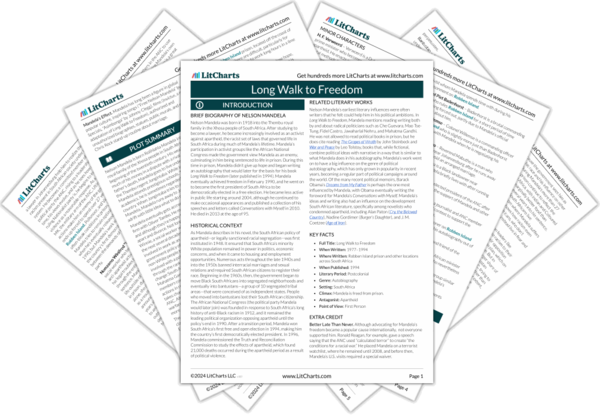Welcome to the LitCharts study guide on Nelson Mandela's Long Walk to Freedom. Created by the original team behind SparkNotes, LitCharts are the world's best literature guides.
Long Walk to Freedom: Introduction
Long Walk to Freedom: Plot Summary
Long Walk to Freedom: Detailed Summary & Analysis
Long Walk to Freedom: Themes
Long Walk to Freedom: Quotes
Long Walk to Freedom: Characters
Long Walk to Freedom: Terms
Long Walk to Freedom: Symbols
Long Walk to Freedom: Theme Wheel
Brief Biography of Nelson Mandela

Historical Context of Long Walk to Freedom
Other Books Related to Long Walk to Freedom
- Full Title: Long Walk to Freedom
- When Written: 1977–1994
- Where Written: Robben Island prison and other locations across South Africa
- When Published: 1994
- Literary Period: Postcolonial
- Genre: Autobiography
- Setting: South Africa
- Climax: Mandela is freed from prison.
- Antagonist: Apartheid
- Point of View: First Person
Extra Credit for Long Walk to Freedom
Better Late Than Never. Although advocating for Mandela’s freedom became a popular cause internationally, not everyone supported him. Ronald Reagan, for example, gave a speech saying that the ANC used “calculated terror” to create “the conditions for a racial war.” He placed Mandela on a terrorist watchlist, where he remained until 2008, and before then, Mandela’s U.S. visits required a special waiver.
Mandela’s Effect. Mandela has long been a figure in global popular culture, inspiring songs (“Free Nelson Mandela” by the Specials, “Asimbonga” by Johnny Clegg), films (Invictus, a movie adaptation of Long Walk to Freedom), authorized and unauthorized biographies, statues, public murals, and even a Chris Rock stand-up routine about marriage.







